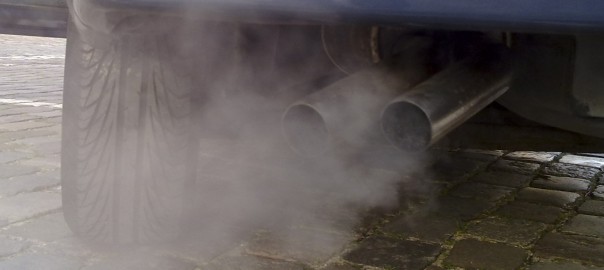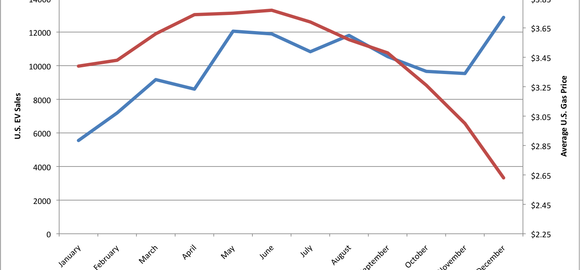LEVA’s Ed Benjamin enumerates the many reasons that plummeting oil prices will not only be short-lived, but that multiple other drivers will compel a shift to electric vehicles
As I write this, the price of Brent Light Crude is $51.35 / bbl. That is down from about $110 / bbl. 7 months earlier.
Filling a car, or an airplane, or a motorcycle, has become much more affordable.
It is easy to believe that this is a serious blow to electric vehicles. We have seen in the past that high fuel price helps move people, investment, and interest to electric vehicles of all sorts.
For many in the electric vehicle business, a high price for oil is a hoped for dream – that appeared to be occurring until last year.
Over the 150+ years of the world oil industry, there has been a repetitive cycle of rising and falling prices. Boom and bust for both oil men and their customers. It is easy to believe that 2014 was simply more of the same. That the high prices of 2008 would never come back, and that technology has solved the oil supply problems of the world. We can relax and keep on buying gasoline cars with confidence…
In my career, I have monitored the price of oil, read on the economics of the oil industry, and been oft surprised at the complex, seemingly mysterious events and contortions of the oil market due to the many forces that act on it.
So when the price of oil dropped so dramatically in 2014, surprising me once again, I looked a bit harder.
A premise that has been floated in the media, was that the Saudis had arranged to pull the price down to destroy the efforts of oilmen who were bringing oil sands, oil shales, and extensive fracking into production. These sources of oil (along with deep ocean wells) are MUCH more expensive sources of oil than the oil fields of the Middle East.
I have seen generalizations that it might cost $1-2 / bbl to find and extract oil from the Saudi wells compared to $70 / bbl for these more difficult sources.
So cheaper oil is still profitable to the Saudis, went the thinking, but discouraging of production, exploration and investment for oil sands, oil shales, fracking and deep ocean production.
Another idea that has some play is that advances in petroleum extraction technology have restored the USA to a nearly self sufficient level of production, and this, plus cheap natural gas, has pushed the price down.
These may be part, but not be the whole, or even the most important part of the story.
A key factor in oil price is the match between supply and demand.
Oil is produced in immense quantities, and then used in immense quantities.
Enough oil is produced every day to fill 600 average oil tankers. Add in the oil that is in motion at any one time…through pipelines, tankers, trucks, and there is a lot of oil requiring storage and transport. Think of it this way: If all oil moved by tanker (more moves by pipeline) and the average time for a tanker to make it’s destination and return was 20 days, then the world would need about 12,000 tankers plying the oceans just to keep the world moving. (But only about 4,000 tankers exist…)
The oil industry depends on smooth and reliable movement of oil from well to refinery to consumers at about the pace in which it is created and consumed. There is limited ability to deal with any sort of disruption, slow down, or sudden extra demand. (Since I live in Florida, I have had direct experience with this. When a hurricane caused shipments of oil to be postponed a few days, nearly every gas station in the southern half of the state was sold out of gasoline in about 30 hours.)
If the world is using 85 million barrels of oil per day…and the oil industry is producing very close to that amount per day….and then demand changes….the results can be dramatic.
If oil demand was only 1% less than production – the result would be about 850,000 extra barrels of oil EVERY day. There are not a lot of ways for the industry to store extra oil, and one way to think of this is that the extra oil would, in one month, fill about 150 average oil tankers swinging on their anchors with no place to take the oil. The oil storage facilities of the world are simply not big enough to handle such mismatches in production and demand.

Such a mismatch exists today. Partly blamed on mistakes in projections of world use, partly due to the increased supplies coming in the USA.
Graphs of fuel consumption in the developed world show that, unlike expectations that there would be a steady growth in fuel consumption, today’s consumption is declining instead. This may have contributed to errors in planning of production.
This reduced consumption is attributed to cars with better gas mileage, reduced mileage being driven by Americans, and a less than stellar economy world wide.
Consumption in the developing world is both heavily affected by price, and is the primary driver of increased oil consumption world wide. Thus, high prices limit growth. Which combined with decreased consumption by the “high price” market, the slow down hit oil predictions hard.
So the oil price must drop until it is low enough to spur enough consumption to use all the oil being produced. Normally this would happen in combination with production being slowed and prices being kept relatively high – but in 2014, the Saudis did not decrease production, as they have in the past, keeping the mismatch going. So the price kept dropping. We can speculate that this will not continue for a long time, since every one in the oil business, including the Saudis, suffers from this big dip in revenue.
Something else to understand is that the world is currently using, mostly, oil that comes from huge oil fields that were discovered decades in the past. These fields could be tapped by drilling a well, and the pressure present in the oil field would push oil into the well in …. ever decreasing quantities as the field was depleted. And when the well was on land – even in a desert, it was vey convenient, and inexpensive to drill and transport. The discovery of such oil fields peaked in the 60’s and 70’s and the far fewer recent discoveries are in places that are… hard and expensive to reach.
The oil from such fields is what most refineries are designed to handle, and that is also very important. Refineries are designed to handle certain sorts of oil. When an oil is different, it may need to be shipped great distances to appropriate facilities. And refineries are multi billion dollar investments that are built rarely. (Most USA refineries were built in the 60’s and 70’s. )
These fields, near 1000 “giant” oil fields share some important characteristics. First, they are ALL in decline. Most of them are in politically unstable places. They have been worked as hard as technology and investment knows how, and there is probably not much that can be done to improve their decline in production. In the last decade, only about 75 new giant oil fields have been discovered, and except for the ones in the Arctic, they are in the same general areas as the existing fields.
New discoveries in oil supplies can be generalized as: Expensive, inconvenient, and often the wrong type of oil.
The USA consumers and much of the world are currently relaxing in the face of low gas prices. Overall, it is very good news as the vast amounts of money that are being saved by consumers is not only improving their lives, but is also being spent on goods an services instead of being stored in the accounts of sovereign wealth funds, or pockets of billionaires. This is a much needed help in today’s difficult economy.
But there are some issues that are not obvious.
Much of the increased oil production in the USA is lighter crude. Not only is that not the most useful or versatile oil, but is is refined by only a few plants.
Oil from oil sands and oil shales is energy intensive to extract and refine. While the technology changes all the time, at present there is avery large amount of energy required to extract oil from oil sands, as a percentage of the total energy that is created as usable fuels. There are some dramatic environmental costs associated with that. And this means that is is more expensive in many dimensions.
There is a dramatic increase in the production of natural gas in the USA. And the technology for this increase is expected to result in major increases in natural gas production world wide in coming years. NG is used in minor quantities for vehicle fuels, but very heavily for electrical generation. It has replaced some oil that was burned for electricity.
The extraction methods for this NG, and for the oil are controversial, with claims that there is substantial environmental damage – especially to water supplies.
New NG supplies have the primary effect of reducing the demand for coal. (And NG has fewer adverse environmental effects.)
Should we fear that the lower price of oil, no matter what the reason, will hamper the development and sale of electric vehicles?
My answer: Maybe a little.
I am not going to change my career, for I see this as a temporary factor, one that is good for consumers, and has limited long term effect on either human energy use, or on electric vehicles.
There are many reasons to expect a return to oil priced at more than $100 / bbl.
- All the big oil fields are declining in production. This is not news, but is more and more apparent each year. This decline is substantial.
- Discoveries do not keep pace with consumption
- Newer sources of fossil fuels cost dramatically more to exploit than older ones. $70 / bbl is an oft citied floor for such sources. Many new discoveries will not be profitable until oil is even more expensive than that.
- The expanded production in the USA is very light crude, and thought to be limited in quantity.
- Many existing fields are in places that are in political turmoil, or bordered by such turmoil. War, sanctions, unrest, sabotage, neglected infrastructure, and other problems are found at the locations of perhaps half the world’s oil.
- The economies of major oil producers (Russia is an example) depend on high priced oil. Russia is similar to Saudi Arabia in oil production quantity and they, and other producers, will strive to get the price back up. And even for the Saudi’s, higher oil prices are very good for their pockets.
- The claimed reserves of any and all oil producers must be regarded as suspect. Over history, what the industry claims to have, often seems to be fiction.
- They have had huge and sudden adjustments (usually downward) to what they claim to have available as taxes, quotas, and politics affect them. And in some cases (Saudi Arabia) their claims have never been audited by outside parties. Even the claims of USA oil and gas producers are controversial, with some voices predicting that the fracking and NG boom of today is going to be much shorter lived than the producers claim.
So, I predict, with confidence, that we will see $100/bbl oil again, and soon.
All of the oil producers are eager to see high priced oil as soon as possible. The economies of several nations depend on the revenues, and we can rely on them to find a way to increase the prices.
And the booms in energy production created by numerous new wells in existing fields, new methods of extraction and fracking are going to be short lived. Although it is hard to say exactly what that will mean. It could range from a few years to a few decades, but experts are saying it is more likely to be shorter than longer.
But…oil price is not the only driver for the electric two wheeler market. We do not depend on high priced oil as much as might be thought. (And keep in mind that $53.00 / bbl oil is low priced only compared to recent years. Not long ago (2000) we thought $12.00 /bbl was a reasonable price…)
I have come to believe that these drivers are much more important than the price of oil:
- Humans all over the world are moving into bigger and denser cities. This is typified by 20 odd story apartment buildings standing a few meters apart, for many square kilometers. There is no need for a car since most daily services are within a short walk, and the workplace is reached by a metro or bus that can be reached on foot or bicycle. When 45,000 or more people live in a square kilometer, there is no room for big roads, no parking lots, no tolerance for noise or air pollution. Bicycles, electric bikes, and electric scooters are better choices.
- People are starting to understand that electric vehicles are functional, affordable, reliable, and superior in many ways. This has been a lesson slow to be learned, but with Tesla the new status automobile, the Prius the suburban mom required vehicle, and electric vehicles of all sorts proliferating – the public gets it.
- The world population is also aging. While we have some nations that are, on the average, quite young…many important nations have average ages that make them very interested in electric bikes as extenders of enjoyment and transportation.
- Electric bikes for sport and recreation are now coming into their own. Electric mountain bikes, rental electric bikes at tourist destinations, touring on electric bikes instead of manual bikes are all important extensions of the product.
- Government regulation encourages electric vehicles in many places, and in many ways.
- Many people seek ways to reduce their personal carbon footprint. Electric vehicles are an affordable way for nearly anyone to do this.
- As the developing world increases in wealth, many will buy cars. But many more will buy powered two wheelers. And today, the electric powered two wheeler is a viable competitor in many cases.
- Air pollution is an important issue for much of humanity. Electricity for charging a two wheeler can easily come from a variety of renewable sources. Or from the existing grid. There is no “tail pipe” to dirty the air.
My conclusion: We face a bright future.
Source: EV World





